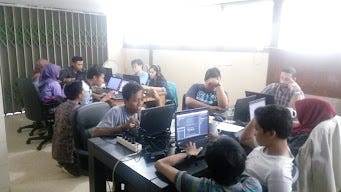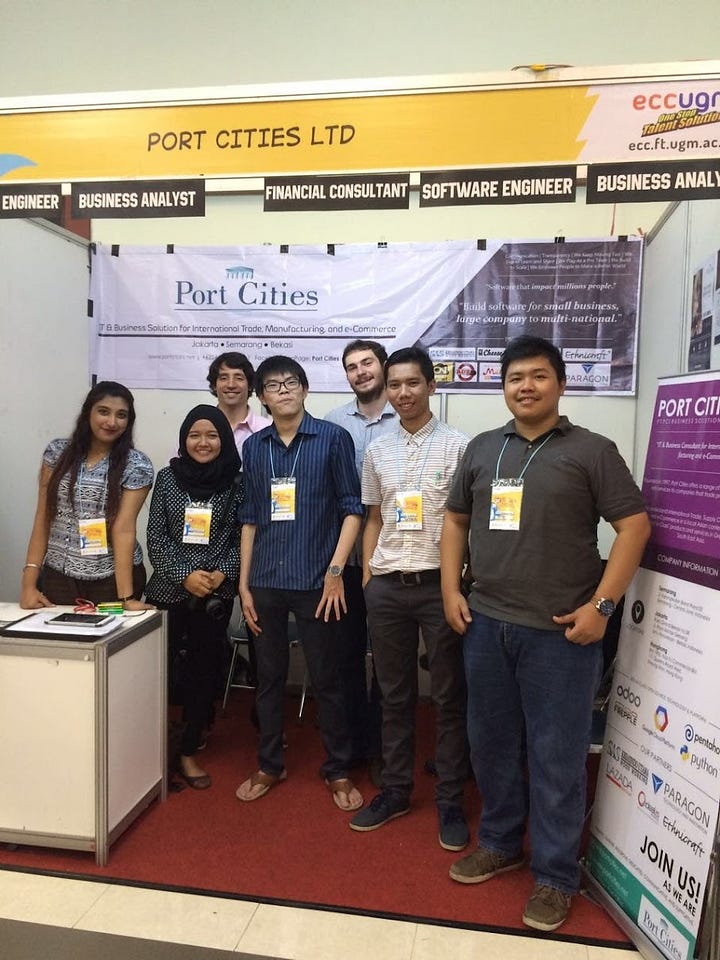Rising ambitions. To become the #1 Odoo partner.
#3 - On setting goals and competition. Why do we want to become the best Odoo partner? And how to measure it?
Hi,
Welcome to issue #3 of Odoo Trailblazer, our journey to become the #1 Odoo partner.
To be honest, as a CEO, you speak all the time to many people with optimism, but in reality, you also often feel anxious and lonely.
Fortunately, I have learned to handle stress a little better over the years. And today, I feel great :-)
Have a great week, and don’t forget to smile; it is free and contagious.
I write this newsletter to share “our journey to become the #1 Odoo partner”, but we never told you why. So let’s go back to when everything started in 2015.
What was our ambition, and how did it evolve? Why do we want to become the #1 Odoo partner today, and how should we measure it?
Agenda
Backstories: rising ambitions
Business update: follow-up on our organizational change
To become the #1 Odoo partner. The “why” and the “what”.
To have a simple and measurable goal
Competition makes us stronger
To open-source it
What are the criteria to be #1? For Odoo
What are the criteria to be#1? For Port Cities
Next steps
1. Backstories: rising ambitions
My initial target for our business when we started in 2015 was:
To create a real business and grow it to $400k (in Indonesia, it is the equivalent of a $1.3m business in the USA if you adjust PPP like for the GDP).
Later our goals would change many times to:
Digitizing all the tiny e-commerce resellers in Indonesia for Lazada.
Growing a large Odoo service firm in Indonesia and Southeast Asia unreasonably fast.
Becoming the #1 Odoo partner worldwide.
a. Create a real business and grow it to $400k
I could try to sell it (even for a low price), and I would be proud of it. I was only 26 when we started Port Cities, and it would be a great learning experience for me, at least as good as doing an MBA.
The initial target was achieved in the second year, and we revised it many times.
b. To digitize all tiny e-commerce resellers in Indonesia
In 2015 we met with some people from Lazada, the leading e-commerce company in Southeast Asia at the time. They wanted a better logistics system for their resellers (all the small shops selling on Lazada).
So, we built a prototype and installed it, but it was not a sustainable business unless we could onboard hundreds of sellers.
We made a business plan and pitched it to Lazada C-Suite in Singapore.
We finally dropped this ambition, but it was a crazy experience.
c. Growing a large Odoo service firm in Indonesia and Southeast Asia
We wanted to grow exponentially;
To hire hundreds of employees
To grow from $500k to $16m
All in 3 years with a small investment
Our first target was too low, and the latest one was clearly too high.
We are at ~$8m in revenue today, six years later. So we’re finally getting closer to $16m.
For the story, we grew super fast in some of our quarters:



In 2015 we rented our first office in Semarang and paid for three years upfront, but we had to move after 18 months because it was so “packed”.


Before taking any investment, we started to hire 1-2 people per week because our Jakarta business was booming. We joined one job fair per month all over Java.
We initially grew very fast with very limited cash flow, and we bought everything secondhand, including computers and furniture. This was a “Mem” shared on our “all-employee” WhatsApp group after we finally “invested” in a decent water dispenser. It says, “PCI has a new dispenser”, and Wayu (an ex-Port Citizen) definitely looks so happy about it.
Today, our target is to be the #1 Odoo partner worldwide.
2. Business update: follow-up on our organizational change
In the last two issues, we presented;
Issue 1 (link): our new business organization for 2023, to group our business by region.
Issue 2 (link): why do we set profit targets of 25% for these new regions?
The re-organization by region is a big change for many team members. This initiative is mostly led by Charles, co-founder and COO. Each week he helps the leadership team of each region to align their mindset and priorities with the new reality of our business “by region”.
He has already built new consolidated financial reports by region and is now working on financial planning with each “finance leader”.
In our new organization, a director level is responsible for selling and delivering projects, but he also has management responsibility for the region: sales, finance, or delivery.
Our target is to grow evenly in each region.
Services revenue targets by region (in USD per year):
As you see, we estimate pessimist and optimist targets to ensure that we have enough delivery capacity and reasonable margin in both scenarios.
3. To become the #1 Odoo partner
In this newsletter, we write our journey to become the #1 Odoo partner.
What is an “Odoo partner”? It is a service firm reselling the business software Odoo and helping other companies to install, configure, customize, and use it.
So why do we set this goal, and how do we measure it?
Why, in short:
To have a simple and measurable goal that speaks to everyone
Competition: to make us, and the entire Odoo ecosystem, better
Open-source it: get feedback
How to measure it, in short:
Choose simple, measurable metrics instead of perfect ones;
#1: Active Odoo Enterprise licenses
#2: Revenue
#3: Odoo recognition
3a. To have a simple and measurable goal
The “why” #1: we want a simple and motivating goal to chase, for all our employees, to build a great company together.
Many people speak about the importance of discipline in business. You often hear, “improve 1% every day, and in one year, you’ll be …” or anything praising daily routine or discipline.
The problem is that it is very hard to have the right discipline.
In my own experience and observing my team, being obsessed with discipline and routine is a mistake. You better be obsessed with your goals and use discipline as one of the tools to achieve them.
Why?
It is hard to be disciplined. You need to be very motivated. And having clear and specific goals can help you. A better employee usually has clear personal, team, and company goals.
Being the best Odoo partner is the result of the hard work of all our teams. It will make us a better company and help the entire Odoo ecosystem. So I believe it is a good, simple, clear, and inspirational goal to follow as a company.
Goals & Discipline in business & sport: as a long-distance runner, I also know that it is much better to consistently run 2x a week than running crazy for 2-3 weeks and doing nothing for months. Discipline and routine matter.
I often decide about new running habits, but I rarely do it, and not consistently.
Then, things change when I register for a marathon or a serious race where I set a clear and specific target, such as “run the Bromo Marathon 2017 in under three hours”. I’ll usually make a kind of training plan.
I’ll not follow it 100%, but I’ll notice that I suddenly become better at it without even thinking about discipline. I’m now driven to be disciplined because it helps me to achieve my goal.
3b. Competition makes us stronger
The “why” #2: we want the Odoo ecosystem to friendly compete and become stronger
Having this goal also means communicating it, and hopefully, it will drive competition.
Competition drives us, and it drives us to win and improve ourselves.
I hope it will also encourage other Odoo partners to fight harder to become #1 Odoo partners. Maybe, by writing this newsletter, I’ll motivate another Odoo partner to win and beat all of us.
That would be great because we will all fight harder, and build better companies, for our shareholders, the Odoo ecosystem, and the world.
3c. Open-source it
The “why” #3: expect nothing in return, but get it anyway.
Like in the open-source world, we share our journey because we are happy to share. We don’t expect anything in return, and we expect most people only to consume our content.
But we also know that some people will be engaged and share feedback, ideas, and critics. That will motivate us and help us to challenge our plans.
3d. What are the criteria to be #1? For Odoo
According to Odoo, it means selling more Odoo Enterprise licenses and having higher customer retention. This is how you become a Gold partner and how to receive the “Best partner awards”.
From an outsider's perspective, it may seem that those metrics are driven by Odoo's own interest and not representative of what a great partner really is.
However, I agree that this is a very good way for them to measure a partner's greatness or quality:
Odoo cannot collect many metrics objectively because Odoo partners are private companies, and only very few data are available to Odoo itself.
A partner able to sell a lot of Odoo licenses usually has a larger team and the experience to deliver larger (and more complex) projects.
Customer retention is not a perfect metric because customers can change to another partner for cheaper prices. But on average, a better partner will have better retention.
Choosing “sales” and “retention” are simply two good enough metrics that are available and estimate pretty well the partner “quality”, on average.
As per this writing, Port Cities group is 7x official Odoo Gold partners and has been Best Odoo Partner APAC for four consecutive years. So we meet, pretty well, Odoo's criteria already.
3e. What are the criteria to be #1? For Port Cities
So what are our KPIs:
Active licenses (in # of Odoo users).
Yearly revenue
Odoo recognition:
Odoo awards
Ranking on Odoo website partner page
I believe these 3-4 metrics aren’t perfect but simple to measure (or estimate) and aligned with our stakeholder’s interests: our clients, our employees, Odoo, and our shareholders.
If you have better metrics, please share!
These should not be the top KPIs or priorities of any Odoo partner. Each partner should choose his own strategy, KPIs, and yearly objectives to achieve it. But it could be used as simple metrics to benchmark with other Odoo partners and drive us to compete and improve.
As for Port Cities, we have our own strategy and targets for 2023, but this goal is part of our long-term ambition, and we will be happy to share our progress, good or bad.
4. Next steps
Now, let’s get back to our top business priorities:
Finalize our P&L forecast
Finalize our Sales & Marketing plan for 2023
Manage our delivery teams by region. This is the most complex change in our new 2023 organization.
Next week I’ll share our sales & marketing plan or P&L forecast.
Follow us on LinkedIn for more updates: Gaspard (Founder & CEO), or Port Cities (our company page).
To know more about Port Cities, and how we help companies to use Odoo (business software):






